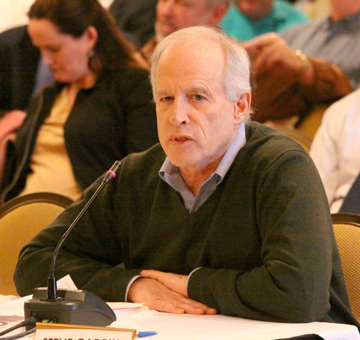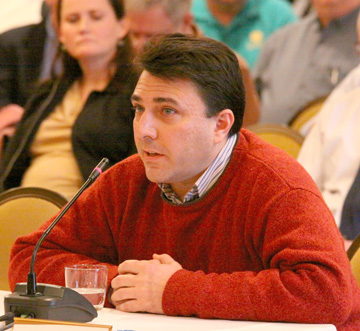Scallop Blow-Up

Peter Shelly, Conservation Law Foundation. “I want to speak to an unprecedented political attack, backed up by some journalists, on the credibility and integrity of the council. I think the threats against the chairman by Congressman Frank are inexcusable.” ©Photo by Sam Murfitt
An outcry from the scallop industry and elected officials from the Northeast persuaded the New England Fishery Management Council (NEFMC) to revisit their November 2009 decision on reduced scallop landings for the 2010 fishing year.
NEFMC took an unprecedented step when they re-opened the discussion regarding Framework 21 to the scallop management plan at their January 2010 meeting.
NEFMC chairman John Pappalardo said he regretted the fallout between the scallop council and NEFMC as a result of the decision. “At some point between the November meeting and today, things went awfully wrong,” said Pappalardo.
In January, NEFMC heard almost six hours of presentations and discussions that persuaded them to reverse their November decision about rules for harvesting sea scallops in 2010.
NEFMC’s January action will give East Coast scallopers 38 “open area” days-at-sea – nine more than the 29 days approved in November, along with the four “access area” trips that were also included in the November action. The access areas are located on Georges Bank and in the Mid-Atlantic and open and close on a rotational basis as scallops reach harvestable sizes.
And the latest decision will give scallopers a catch allocation for 2010 of 47.3 million pounds, rather than the 41.5 million pounds they set in November.
Testimony from fishermen and officials presented economic arguments about the importance of profits to businesses and communities in 2010, in view of the impacts of a serious recession, versus the long-term benefits that are expected to accrue after 2010.
Framework 21 covers three management issues. It sets fishery specifications for the 2010 fishing year, including setting the allowable biological catch (ABC) for the first time, and ensuring the plan is in compliance with new requirements for the protection of sea turtles. It makes area rotation adjustments, if necessary, and includes consideration of a new scallop access area on Georges Bank. And it includes minor adjustments to the observer set-aside program.
A framework action is a mechanism that allows regulators to adjust management measures to achieve specific goals.
In November, NEFMC set a catch allocation of 41.5 million pounds and 29 days-at-sea for the fishery. NEFMC’s November choice of catch allocation for 2010 was influenced by the high fishing mortality rates that were estimated to have occurred in 2008 and 2009.
NEFMC analysts have projected that actual landings significantly exceeded the catch allocation originally set by NEFMC for those two years. The actual landing figures mean that overfishing is occurring – or close to occurring – in the fishery, said analysts. And NEFMC is required by federal law to prevent overfishing.
The original catch allocation for 2008 was 44.4 million pounds; the actual catch for that year was 53 million pounds. The original catch allocation for 2009 was 45.9 million pounds, and the actual catch is estimated to be more than 57 million pounds.
The catch allocation adopted in November by NEFMC for 2010 is a significant decrease from actual catches in 2008 and 2009.

Bob Benasom, Project to Save Seafood and the Ocean, an industry funded daily summary of the news. “The attack on the press and congressman by an entity (Shelly, CLF) that clearly does a great deal of lobbying, was inappropriate.” ©Photo by Sam Murfitt
In November, NEFMC had also considered an allocation for 2010 of 47.3 million pounds and 38 days-at-sea. But they determined that, although the higher allocation would boost landings and revenues in 2010, it would result in lower landings and benefits after 2010, due to localized overfishing. According to a report from NEFMC staff, about 37 percent of the scallop biomass is located in rotational or habitat closures and will not be available to 2010 fishing. This would concentrate fishermen in the open areas, and result in localized depletion, the report said.
And in November, NEFMC determined that, although the 2010 allocation would result in lower landings and revenues, it would result in higher long-term yields and benefits beginning in 2011. The drastic cut in the allocation would also result in less bycatch of endangered yellowtail flounder and sea turtles, NEFMC said.
At NEFMC’s January 2010 meeting, fishermen asked NEFMC to rescind the decision to allocate 41.5 million pounds and 29 days-at-sea and give them the allocation of 47.3 million pounds and 38 days-at-sea.
In their deliberations, NEFMC grappled with the risk of overfishing involved in allowing the higher allocation.
An updated report from NEFMC staff said that, in addition to questions of yield and bycatch, other factors to consider included the non-uniform nature of the fishery, impacts on essential scallop habitat, and impacts on the economic health of fishing communities.
Although the industry accepted NEFMC’s determination that there would have to be a decrease in landings from the level harvested in 2009, they said a 41.5-million-pound allocation would be a terrible blow that would sink many fishermen and related businesses. And they said the low catch allocation was not warranted, since the fishery is not overfished and overfishing is not occurring.
It’s not just a reduction in scallop meats,” said David Gray, general manager for Chesapeake Bay Packing in Newport News, Va. “Real people will lose their jobs.”
New Bedford, Mass., mayor Scott Lang called the November vote a “dramatic breech” of the relationship between the industry and NEFMC. Lang said the decision would have a “disastrous impact,” especially given the general economic recession.
For the city of New Bedford, Lang said, the November decision would mean a $70 million cut in direct fishing revenue and a $250 million impact overall, and extreme hardship for up to 1,000 families in the city.
Jim Kendall, executive director of New Bedford Seafood Consulting, said the issue affects the entire East Coast. “If we suffer today, will it be better tomorrow?” asked Kendall. “There’s an awful lot of uncertainty out there.” Kendall said the November decision would devastate New Bedford, the only port on the East Coast remaining, he said, that offers full service to the fisheries. “The whole East Coast depends on New Bedford in more ways than you can realize,” Kendall said.
Bill Wells, owner of Wells Scallop Co. in Seaford, Va., a family-owned business with one of the largest scallop fleets on the East Coast, said the November decision would mean 15 jobs lost at his company, and a dramatic reduction in hours for his remaining employees. “This is not a one-year hit in 2010,” Wells said. “This is a two-year hit, in 2010 and 2011.”
That decrease will result in lost markets and infrastructure, Wells said. It will be difficult to recover markets and infrastructure in time to accommodate an expected increase in landings in 2011, he said. “I don’t see how the market can react that rapidly,” Wells said. Wells said the November decision would result in drastic price reductions in 2011 as fishermen try to sell their product, and a loss of tens of millions of dollars.
But Peter Shelley, vice president and director of the Conservation Law Foundation’s Massachusetts Advocacy Center, said NEFMC is responsible not just for protecting the industry but all other stakeholders of the resources. Shelley deplored the “political route” taken by the scallop industry to protest the decision.
Oceana, an international ocean conservation organization, supported the lower allocation. “The scallop fishery is one of the most destructive fisheries in operation today,” an Oceana statement to Massachusetts Governor Deval Patrick said. “Dragging pairs of heavy steel dredges across the seafloor, scallop fishing alters marine habitats and has well-known bycatch and injury of both finfish and sea turtles which have been the subject of a string of fishery-specific actions under the Endangered Species Act since the 1990s.
“Open area fishing on days-at-sea is often referred to as ‘scratching bottom’ because of its low efficiency in catching scallops and its high impacts on the seafloor and bycatch. The one proven method to reduce the habitat and bycatch effects of the scallop fishery is to limit fishing effort and direct this effort into times and areas with fewer environmental impacts.”
The lower fishing rate, Oceana said, would accomplish both tasks by decreasing the overall area swept by the fishery, and would reduce effort in the Mid-Atlantic where interactions with sea turtles and critically overfished Southern New England/Mid-Atlantic stocks of yellowtails flounder.
In the end, NEFMC determined that, although the risk of overfishing was higher with the higher allocation, the risk was acceptable when compared with economic costs associated with their November decision.
